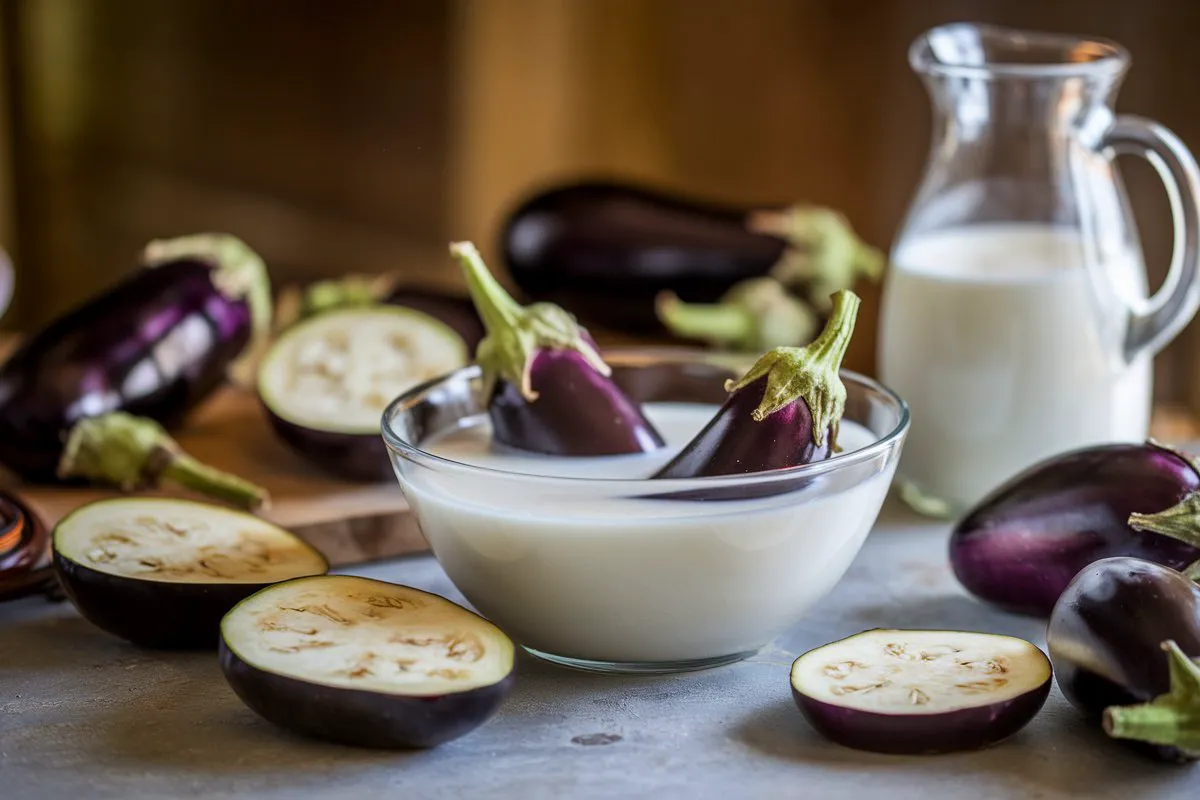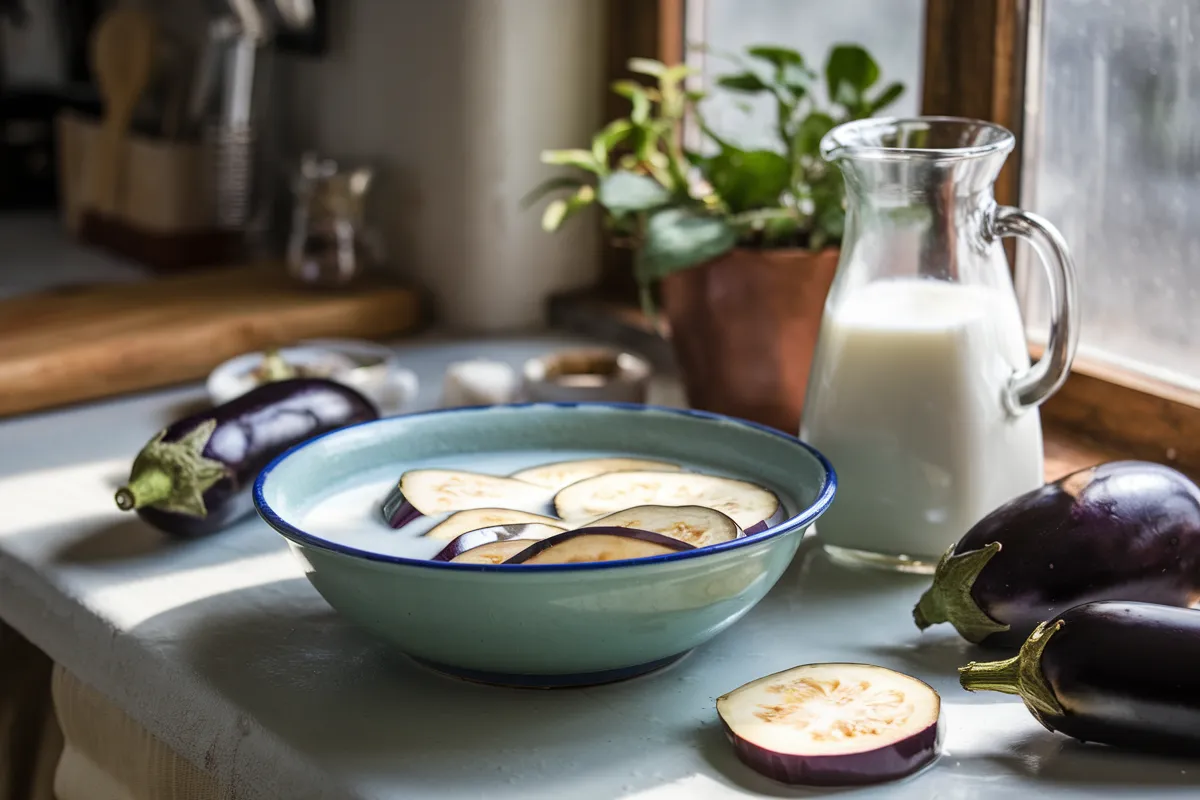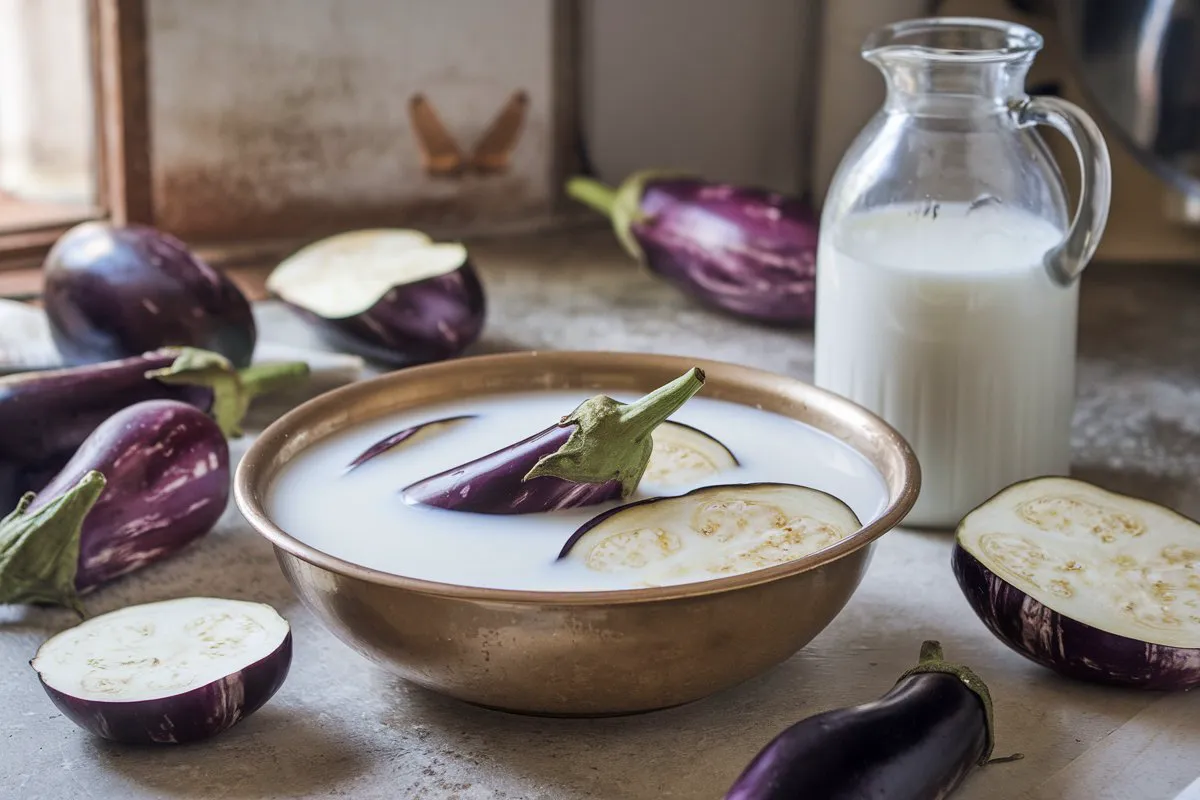Eggplant, also known as aubergine, is a versatile vegetable commonly used in a variety of cuisines around the world. However, many people are unaware of the different techniques that can enhance the flavor and texture of eggplant, one of which is soaking it in milk. This seemingly simple step can make a significant difference in the final dish. In this article, we will explore the reasons behind soaking eggplant in milk, its benefits, and how to properly execute this technique. Additionally, we will dive into other methods of preparing eggplant and some delicious recipes that can showcase the improvements this method brings to your cooking.
Table of Contents
- Introduction to Eggplant
- What is Eggplant?
- Nutritional Benefits of Eggplant
- Common Issues with Cooking Eggplant
- Bitterness in Eggplant
- Spongy Texture of Eggplant
- The Science Behind Soaking Eggplant in Milk
- How Soaking Works
- The Role of Milk in Reducing Bitterness
- Step-by-Step Guide to Soaking Eggplant in Milk
- Selecting the Right Eggplant
- Preparing the Eggplant for Soaking
- How Long to Soak Eggplant in Milk
- Benefits of Soaking Eggplant in Milk
- Enhanced Flavor Profile
- Improved Texture
- Reduced Absorption of Oil
- Other Methods to Prepare Eggplant
- Salting Eggplant
- Grilling Without Soaking
- Roasting for a Different Texture
- Popular Recipes Using Milk-Soaked Eggplant
- Eggplant Parmesan
- Baba Ganoush
- Grilled Eggplant with Garlic Yogurt Sauce
- FAQs About Soaking Eggplant in Milk
- Can You Use Other Liquids Instead of Milk?
- Does Soaking in Milk Remove All Bitterness?
- What Kind of Milk is Best for Soaking Eggplant?
- Conclusion

Introduction to Eggplant
What is Eggplant?
Eggplant, scientifically known as Solanum melongena, is a member of the nightshade family, which also includes tomatoes, potatoes, and bell peppers. This vegetable is known for its deep purple color and unique, slightly bitter flavor. Eggplants can vary in size, shape, and color, ranging from small, round, white varieties to large, oblong purple ones. It is a staple in many Mediterranean, Middle Eastern, and Asian dishes, prized for its ability to absorb flavors and its meaty texture, which makes it a popular meat substitute in vegetarian dishes.
(Insert image of different eggplant varieties with a caption explaining each type.)
Nutritional Benefits of Eggplant
Eggplant is not only delicious but also packed with nutrients. It is low in calories and fat, making it an excellent choice for those watching their weight. Additionally, eggplant is a good source of dietary fiber, which aids in digestion and helps maintain a healthy gut. It is also rich in antioxidants, particularly nasunin, which is found in the skin and helps protect cells from damage. Other nutrients in eggplant include vitamin C, vitamin K, vitamin B6, and potassium.
Read more about the nutritional benefits of eggplant (Internal link suggestion: Link to another blog post about healthy vegetables on your site.)
Common Issues with Cooking Eggplant
Bitterness in Eggplant
One of the most common complaints about eggplant is its bitterness. This bitterness is caused by naturally occurring compounds called glycoalkaloids, specifically solanine. While these compounds are present in small quantities, they can give the eggplant an unpleasant taste, especially in older or larger eggplants.
Why does eggplant taste bitter? Learn more (External link to a reputable cooking website.)
Spongy Texture of Eggplant
Another issue with eggplant is its spongy texture. Eggplants have a porous flesh, which means they can soak up a significant amount of oil when fried or sautéed. This can make the dish greasy and unappetizing. Additionally, if not cooked properly, eggplant can turn out mushy, which can be off-putting to some people.
The Science Behind Soaking Eggplant in Milk
How Soaking Works
Soaking eggplant in milk is a traditional method used by cooks to reduce bitterness and improve texture. But how exactly does this work? The milk acts as a mild buffer that helps to draw out the bitter compounds from the eggplant. When the eggplant slices are soaked in milk, they release some of their solanine into the liquid, resulting in a milder taste.
The Role of Milk in Reducing Bitterness
Milk not only helps in leaching out the bitterness but also adds a subtle creaminess to the eggplant. The proteins and fats in milk can help to mellow out the harsh flavors, making the eggplant taste smoother and more palatable. This is particularly beneficial when preparing dishes that rely on the delicate balance of flavors, such as moussaka or ratatouille.
How to get rid of bitterness in vegetables (External link to a reputable cooking website.)
Step-by-Step Guide to Soaking Eggplant in Milk
Selecting the Right Eggplant
Before you begin soaking your eggplant, it is important to select the right one. Look for eggplants that are firm, with smooth, shiny skin and no blemishes or soft spots. Smaller eggplants tend to be less bitter than larger ones, so opt for medium-sized varieties if possible.
Preparing the Eggplant for Soaking
Start by washing the eggplant thoroughly to remove any dirt or pesticides. Next, slice the eggplant into even pieces. The thickness of the slices will depend on the recipe you are preparing, but generally, ½-inch slices work well for most dishes. If your recipe calls for cubed eggplant, you can cut the slices into smaller chunks.
How Long to Soak Eggplant in Milk
Place the eggplant slices in a large bowl or shallow dish. Pour enough milk over the eggplant to completely cover the slices. Let the eggplant soak for at least 30 minutes, but you can leave it for up to an hour for better results. After soaking, drain the eggplant and pat it dry with paper towels before cooking.
Benefits of Soaking Eggplant in Milk
Enhanced Flavor Profile
Soaking eggplant in milk significantly enhances its flavor. The bitterness that many people find off-putting is reduced, allowing the natural sweetness of the eggplant to shine through. This makes the vegetable more versatile and enjoyable in a wider range of dishes.
Improved Texture
Milk-soaked eggplant has a firmer texture, which is ideal for recipes that require the vegetable to hold its shape, such as grilled eggplant or eggplant Parmesan. The soaking process also helps prevent the eggplant from absorbing too much oil during cooking, which can make the dish greasy.
Reduced Absorption of Oil
One of the most frustrating things about cooking eggplant is its tendency to soak up oil like a sponge. By soaking the eggplant in milk beforehand, you create a barrier that reduces the amount of oil the eggplant absorbs. This not only makes the dish healthier but also allows the flavors of the other ingredients to come through more clearly.

Other Methods to Prepare Eggplant
Salting Eggplant
Another traditional method to reduce bitterness and moisture in eggplant is salting. This involves sprinkling salt over the eggplant slices and letting them sit for 30 minutes to an hour. The salt draws out moisture, which can carry some of the bitter compounds with it. After salting, the eggplant should be rinsed and patted dry before cooking.
Grilling Without Soaking
If you’re short on time, grilling eggplant without soaking it in milk can still yield delicious results. Grilling adds a smoky flavor that complements the natural taste of the eggplant. To prevent the eggplant from becoming too oily, brush it lightly with olive oil before grilling.
Check out our grilled vegetables guide (Internal link suggestion: Link to another article about grilling vegetables on your site.)
Roasting for a Different Texture
Roasting is another excellent way to cook eggplant, especially if you’re looking for a different texture. Roasted eggplant becomes soft and creamy, making it ideal for dips like baba ganoush. You can roast the eggplant whole or cut it into cubes, depending on the recipe.
Popular Recipes Using Milk-Soaked Eggplant
Eggplant Parmesan
Eggplant Parmesan is a classic Italian dish that benefits greatly from soaking the eggplant in milk. The soaking process ensures that the eggplant slices remain firm and don’t become soggy when layered with marinara sauce and cheese. To make Eggplant Parmesan, start by breading and frying the milk-soaked eggplant slices. Then, layer them in a baking dish with marinara sauce, mozzarella, and Parmesan cheese. Bake until the cheese is bubbly and golden brown.
(Insert an image of Eggplant Parmesan, ideally just before baking with melted cheese.)
Baba Ganoush
Baba ganoush is a smoky, creamy dip made from roasted eggplant, tahini, garlic, and lemon juice. Soaking the eggplant in milk before roasting helps to mellow out any bitterness, resulting in a smoother, more balanced dip. Serve baba ganoush with pita bread or fresh vegetables for a delicious appetizer.
Grilled Eggplant with Garlic Yogurt Sauce
Grilled eggplant is a simple yet flavorful dish that can be served as a side or main course. After soaking the eggplant in milk, grill the slices until they are tender and slightly charred. Serve the grilled eggplant with a garlic yogurt sauce made from Greek yogurt, minced garlic, lemon juice, and fresh herbs. This dish is perfect for summer barbecues or as a light, healthy dinner.
FAQs About Soaking Eggplant in Milk
Can You Use Other Liquids Instead of Milk?
While milk is the most commonly used liquid for soaking eggplant, you can experiment with other liquids such as buttermilk, yogurt, or even a mild brine. Each liquid will impart a different flavor and texture to the eggplant, so feel free to get creative with your cooking.
Does Soaking in Milk Remove All Bitterness?
Soaking in milk significantly reduces the bitterness in eggplant, but it may not remove it entirely, especially if the eggplant is very large or overripe. For best results, choose smaller, younger eggplants and combine the soaking method with salting if you are particularly sensitive to bitterness.
What Kind of Milk is Best for Soaking Eggplant?
Whole milk is the best choice for soaking eggplant because of its higher fat content, which helps to mellow out the bitterness. However, you can use low-fat or non-dairy milk alternatives if you prefer. Just keep in mind that the results may vary slightly depending on the type of milk you use.
Looking for more tips on reducing bitterness in vegetables? (Internal link suggestion: Link to another article on your site about cooking tips for vegetables.)
Conclusion
Soaking eggplant in milk is a simple yet effective technique that can transform your cooking. By reducing bitterness, improving texture, and preventing excessive oil absorption, this method allows the true flavor of the eggplant to shine through. Whether you’re making Eggplant Parmesan, baba ganoush, or grilled eggplant, soaking in milk can help elevate your dish to the next level. Experiment with this method in your kitchen and discover how it can enhance your favorite eggplant recipes.
FAQs
- Is it necessary to peel the eggplant before soaking it in milk?
- Peeling is optional and depends on personal preference. The skin contains additional nutrients and adds texture, but if you prefer a smoother dish, feel free to peel the eggplant before soaking.
- Can I soak eggplant overnight?
- Yes, you can soak eggplant in milk overnight, especially if you’re preparing it for a large meal the next day. Just be sure to cover and refrigerate it to prevent any spoilage.
- Will soaking eggplant in milk change the color of the dish?
- Soaking in milk will not significantly alter the color of the eggplant or the final dish, though it may slightly lighten the flesh.
- How can I store leftover soaked eggplant?
- After soaking, drain and dry the eggplant, then store it in an airtight container in the refrigerator for up to 24 hours before cooking.
- Can I use flavored or sweetened milk for soaking eggplant?
- It’s best to use plain, unsweetened milk to avoid introducing unwanted flavors to your dish. Flavored or sweetened milk might alter the taste in an undesirable way.

